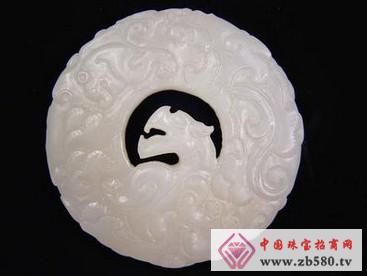The jade articles of the Han Dynasty (206 BC to 220 AD) inherited the tradition of jade articles in the Warring States Period and changed and developed.

The ceremonial jade articles (the so-called "Ruiyu") are reduced in comparison. The various jade articles that make up the ornaments are simplified in type, the jade articles used for funerals are significantly increased, and the jade articles and decorations are also greatly developed. In the carving process, the round carvings, high reliefs, openwork jade and jade objects are increasing. The style of the ornamentation is mainly from the abstraction to the realism. Some of the jade articles like the real jade also have the sense of reality and vitality. The gods can be skillfully combined into one, which are beyond the reach of the pre-Qin jade.
After the founding of the People's Republic of China, the number and variety of jade artifacts unearthed in the Han Dynasty were many, and the scientific value greatly exceeded the handed down products. Some of the unearthed jade articles are the tombs of some Han Dynasty princes and their relatives, such as the tomb of Nanyue King in Guangzhou, Guangdong (see the jade of the Nanyue King tomb in the Western Han Dynasty), the tomb of Liu Sheng and the couple in Jingcheng, Hebei, and the tomb of Liu Xiu in Zhongshan, Hebei Province. Liu Yu's tomb, Mu Wang Liu Chang's tomb, Beijing's Dabantai Guangyang Wang and his wife's tomb, Jiangsu Xuzhou Chu Wang Tomb, Henan Province Shangqiu Liang Wang Tomb. In addition, there are some fine jade articles in the Han Dynasty.
Etiquettes, decorations and fine arts made in various jade materials in the Han Dynasty. China's craftsmanship has a long history and the Han Dynasty continues to develop. The jade in the early Western Han Dynasty inherited the tradition of the Warring States period, but it began to change. After the Western Han Dynasty, the change was even greater. According to different shapes and uses, the Han Dynasty jade can be divided into four categories: 1 jade used in the ceremony; 2 buried jade; 3 jade decorations; 4 jade art. The six kinds of “Ruiyu†of Shang and Zhou Dynasties, except for ç’§ and åœ, are discarded. The variety and quantity of various jade articles that constitute “group jade†have been reduced. There are more types of funerary jade and jade ornaments. The surface pattern changed from abstraction to realism. Round carvings, high reliefs, openwork, and jade carvings have also increased. These changes reflect changes in the Han society and changes in customs and thoughts (especially religious ideas). In the history of Chinese jade, the Han Dynasty was a transitional stage.
Rayon Elastic Slub Single,Rayon Slub Effect Woven Fabric,Rayon Company,Rayon Factory
Shaoxing Shangda Textile Co., Ltd , https://www.shangdatex.com